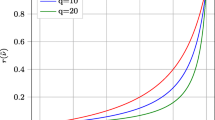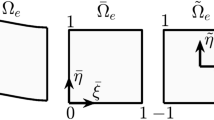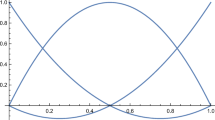Abstract
This article presents a new method for evaluating stresses in the jagged structures that arise when using a fixed finite element mesh to optimize the topology of a structure. The new method, Interior Value Extrapolation, IVE, exploits the fact that in the interior of the structure, the stresses calculated by the finite element method are more accurate than at the boundary. The jagged nature of the mesh makes stresses at the boundary oscillate. Therefore, stresses at the boundary are instead extrapolated from results in the interior, resulting in a more stable and accurate stress measure. A restriction method in the form of a non linear density filter is also proposed, tailored to be used in conjunction with the new stress evaluation method. The new method is evaluated for accuracy using example geometries, for which the stresses are known. It is shown that IVE improves the accuracy of the stress calculation. Optimization examples are thereafter solved with and without IVE, and the results are discussed. It is shown that the change in stress evaluation can in fact cause changes in the solution of a typical stress minimization problem.

























Similar content being viewed by others
References
Bendsøe M, Sigmund O (2004) Topology optimisation. Springer, Dordrecht
Bendsøe MP, Sigmund O (1999) Material interpolation schemes in topology optimization. Arch Appl Mech 69:635–654
Bourdin B (2001) Filters in topology optimization. Int J Numer Methods Eng 50(9):2143–2158
Bruggi M (2008) On an alternative approach to stress constraints relaxation in topology optimization. Struct Multidiscip Optim 36:125–141. doi:10.1007/s00158-007-0203-6
Bruggi M, Duysinx P (2012) Topology optimization for minimum weight with compliance and stress constraints. Struct Multidiscip Optim 46:369–384. doi:10.1007/s00158-012-0759-7
Bruns TE, Tortorelli DA (2001) Topology optimization of non-linear elastic structures and compliant mechanisms. Comput Methods Appl Mech Eng 190(26-27):3443–3459
Cheng G, Guo X (1997) 𝜖-relaxed approach in structural topology optimization. Struct Optim 13:258–266. doi:10.1007/BF01197454
Duysinx P, Bendsøe MP (1998) Topology optimization of continuum structures with local stress constraints. Int J Numer Methods Eng 43(8):1453–1478
Guest JK, Prévost JH, Belytschko T (2004) Achieving minimum length scale in topology optimization using nodal design variables and projection functions. Int J Numer Methods Eng 61(2):238–254
Kirsch U (1990) On singular topologies in optimum structural design. Struct Optim 2:133–142. doi:10.1007/BF01836562
Le C, Norato J, Bruns T, Ha C, Tortorelli D (2010) Stress-based topology optimization for continua. Struct Multidisc Optim 41:605–620
Roark R, Young W (1989) Roark’s formulas for stress and strain. McGraw-Hill international editions. McGraw-Hill, New York
Rozvany G (2001) On design-dependent constraints and singular topologies. Struct Multidiscip Optim 21:164–172. doi:10.1007/s001580050181
Sigmund O (1997) On the design of compliant mechanisms using topology optimization. Mechan Struct Mach 25(4):493– 524
Sigmund O (2007) Morphology-based black and white filters for topology optimization. Struct Multidisc Optim 33:401–424
Svanberg K (1987) The method of moving asymptotes - a new method for structural optimization. Int J Numer Methods Eng 24(2):359–373
Svanberg K, Svärd H (2013) Density filters for topology optimization based on the pythagorean means. Struct Multidiscip Optim 48(5):859–875. doi:10.1007/s00158-013-0938-1
Acknowledgments
The author wishes to express his deepest gratitude to Professor Mårten Olsson, Department of Solid Mechanics, and Professor Krister Svanberg, Department of Mathematics, both at KTH Royal Institute of Technology, for valuable discussions during the course of this work. The author also wishes to thank Scania CV AB for supporting this work. This work received support from the Swedish Research Council, through the industrial doctoral student grant “Topology optimization of fatigue-constrained structures“.
Author information
Authors and Affiliations
Corresponding author
Additional information
Parts of the contents of this manuscript were presented at WCSMO-10.
Appendix: Proofs of claims
Appendix: Proofs of claims
1.1 Proof of Proposition 1
In Fig. 26, two circles, C 1 and C 2, with radius r m i n are drawn, touching at the point \(\hat {\mathbf {x}}\). A disc with radius δ < r m i n , centered at \(\hat {\mathbf {x}}\), is also indicated. By the assumptions, the boundary of Ω lies between C 1 and C 2. Specifically, the boundary within the disc lies between the straight red lines shown in the figure.
In Fig. 26, the angle ϕ between the red line and the u-axis satisfies: \(\sin {\phi } = \delta /(2r_{min})\). Let the u-coordinate of the center of gravity of \({\Omega } \cap B(\hat {\mathbf {x}},\delta )\) be \(u_{CG}(\hat {\mathbf {x}},\delta )\). The maximal deviation from the v-axis of the center of gravity is limited by the case when the area between the red lines is filled with material on one side of the v-axis, and empty on the other. For this limiting case, the center of gravity is at the distance \(\frac {4\delta }{3\pi }\) from the origin, and at the angle ϕ from the v-axis, which gives the following inequality:
For the v-coordinate of the center of gravity of \({\Omega } \cap B(\hat {\mathbf {x}},\delta )\), there are two limiting cases: when the area between the red lines is full of material, and when the area between the red lines is empty. The v-coordinate of the center of gravity of two objects can be calculated as \( v_{CG} = \frac { A_{1} v_{1} + A_{2} v_{2}}{A_{1} + A_{2}}\), where A i is the area of object i and v i is the v-coordinate of the center of gravity of object i. For the limiting cases, the circle contains a half circular sector of material, with \(A_{1}=\frac {\pi \delta ^{2}}{2} \) and \(v_{1}=-\frac {4\delta }{3\pi }\), and two circular sectors with the angle ϕ, with total area A 2=ϕ δ 2 and |v 2|≤δ. Thus, for the case when the area between the red lines is filled:
and the case when the area between the red lines is empty:
1.2 Proof of Proposition 2
Since δ < r m i n , \({\Omega } \cap B(\hat {\mathbf {x}},\delta )\) consists of two parts: one connected part of material and one connected part of void.
Let the area of \(B(\hat {\mathbf {x}},\delta )\cap {\Omega }\) be A, which is finite and independent of l. The length of the boundary of \({\Omega } \cap B(\hat {\mathbf {x}},\delta )\) is bounded above by 2π δ. Denote the orthogonal distance from a point x on ∂Ω to \(\partial \bar {\Omega }\) as the discretization error at x. The maximum discretization error at any point is bounded above by l, and hence the maximum difference in area between \({\Omega } \cap B(\hat {\mathbf {x}},\delta )\) and \(\bar {\Omega } \cap B(\hat {\mathbf {x}},\delta )\) is A e =(2π δ)l. Let the center of gravity of the difference between \({\Omega } \cap B(\hat {\mathbf {x}},\delta )\) and \(\bar {\Omega } \cap B(\hat {\mathbf {x}},\delta )\) be x e . For the worst case, when all this area is situated at radius (δ+l) from \(\hat {\mathbf {x}}\), the following inequalities hold:
which tends to zero as l tends to zero, since A is finite and A e vanishes when l tends to zero.
Rights and permissions
About this article
Cite this article
Svärd, H. Interior value extrapolation: a new method for stress evaluation during topology optimization. Struct Multidisc Optim 51, 613–629 (2015). https://doi.org/10.1007/s00158-014-1171-2
Received:
Revised:
Accepted:
Published:
Issue Date:
DOI: https://doi.org/10.1007/s00158-014-1171-2





